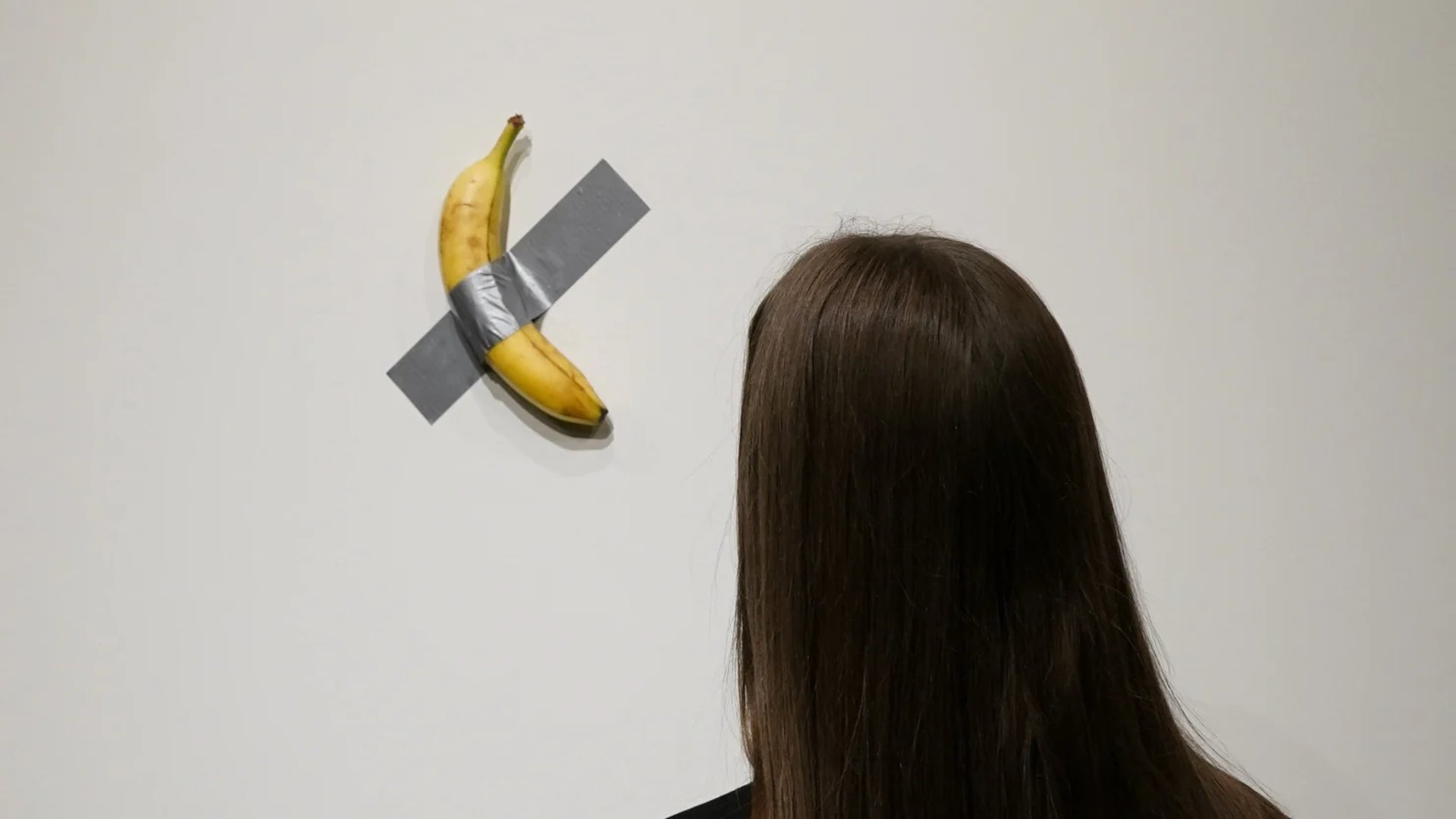
The $6.2 Million Banana: Duct-Taped Banana Sticks Around as a Viral Sensation
A banana duct-taped to a wall, sold for $6.2 million at Sotheby’s, far surpassing its prior sales and estimates. The sale ignited debate over art's definition and value.
Chasing the Current
11/21/20244 min read
Crypto Investor Pays $6 Million for a Banana—And Plans to Eat It: The Bold Collision of Wealth, Art, and Audacity
A headline like this is bound to grab attention, blending the absurdity of a high art price tag with the audacious attitude of a crypto mogul. Imagine a world where Maurizio Cattelan’s infamous "Comedian"—a duct-taped banana turned into a cultural phenomenon—finds itself in the hands of a crypto investor, someone unbound by traditional norms or financial restraint. This eccentric buyer drops $6 million in cryptocurrency for the conceptual artwork, only to announce their intention to eat the banana.
The act would epitomize the philosophy of "YOLO wealth," often associated with the crypto community. It mocks the traditional art world's reverence for objects, reducing an absurdly priced piece to its base value—a snack. Simultaneously, it underscores the ephemeral nature of both modern wealth and art, where a banana and digital currency alike are fleeting.
Eating the banana could also symbolize a form of rebellion: rejecting the constraints of art world elitism and reinterpreting the piece not as a museum relic but as an experience. The gesture would likely go viral, adding another layer to the artwork's legacy while raising new questions about ownership, value, and the intersection of wealth and creativity in a digital age.
The banana, purchased earlier for $0.35 from a fruit stand, now holds its place as one of the most expensive conceptual artworks.
Tron founder Justin Sun buys Maurizio Cattelan’s controversial artwork, Comedian, a banana duct-taped to a wall, for $6.24 million at Sotheby’s contemporary art auction in New York on Wednesday. Justin Sun secured the piece in a heated five-minute bidding war involving six participants, surpassing the $1.5 million pre-sale estimate.
Sotheby’s accepted cryptocurrency payments for sale after Bitcoin topped $96k, reflecting the growing synergy between the art and crypto worlds. Sun plans to eat the banana in an act he described as “honoring its place in both art history and popular culture.”
What is Maurizio Cattelan's Comedian?
In the world of contemporary art, it's not every day that you come across a piece as provocative as Maurizio Cattelan's "Comedian." Imagine a simple banana duct-taped to a wall, sold for an astonishing $6.2 million at a Sotheby's auction. Yes, you read that right—$6.2 million for a piece that could be easily replicated! This artwork has thrust the art world into a whirlwind of conversation about what art truly means today.
The Auction and Its Surprising Outcome
The banana, purchased earlier for $0.35 from a fruit stand, now holds its place as one of the most expensive conceptual artworks. Experts view its success as a testament to art’s power to provoke, even in a challenging market. Initially, Cattelan's banana was estimated to fetch around $10,000 to $15,000, making the final sale price quite a shocking turn of events. This significant leap in pricing raises eyebrows and questions about the valuation of art. What does it say about collectors, the market, and our expectations of art's worth? Are people valuing the bananas—or the idea behind them? As the auction unfolded, the conclusion left both art enthusiasts and casual observers buzzing.
The Debate Over Art and Value
The media frenzy surrounding the sale not only highlighted the unusual nature of the artwork itself but also sparked debates about the very essence of art. Is Comedian a revolutionary statement or a gimmick? It gets more complicated since the buyer didn't acquire the banana itself. Instead, they received a certificate of authenticity, allowing them to create their own iteration of this now-infamous piece. The transient nature of the banana invokes questions about permanence in art, especially when we consider how quickly bananas spoil!
This artwork has catapulted into popular culture, with jokes, memes, and parodies flooding social media. Its simplicity and unconventional format challenge our definitions of what can be classified as art. Many might not relate to its high price tag, but it emphasizes the often unpredictable and sometimes bizarre tendencies of the art market.
In looking at Comedian, we are encouraged to ponder broader themes around artistic intention, authenticity, and commodification. What does it mean when a banana can sell for millions? It exemplifies how art can push boundaries—the idea behind the duct-taped banana holds as much weight as the object itself, if not more.
A Stark Symbol of Inequality
Many people have argued that a duct-taped banana sells for $6.2M amid global cost-of-living crisis. As families worldwide struggle with soaring inflation, housing shortages, and rising grocery bills, the news that a duct-taped banana—Maurizio Cattelan’s infamous "Comedian"—fetched $5.2 million at auction feels almost surreal. The staggering price tag highlights the growing chasm between the ultra-wealthy and the everyday individual grappling with basic survival.
The sale has sparked fierce debate about the priorities of wealth allocation in an era where millions face financial hardship. Critics argue that spending millions on an artwork that is, at its core, a perishable banana, is an audacious display of privilege and detachment. It serves as a powerful (if unintentional) commentary on global economic disparity, where the price of a symbolic fruit can outstrip the lifetime earnings of many workers.
Supporters of the sale, however, point to the piece’s conceptual nature, arguing that its value lies not in the banana but in its ability to provoke thought and discourse about art, value, and society. They suggest that the price tag reflects a growing appetite for avant-garde investments that push cultural boundaries.
Still, the juxtaposition of this sale against a backdrop of economic uncertainty underscores the irony of the modern art market. While millions fret over grocery bills, an elite few bid millions for a fruit taped to a wall—offering a sobering snapshot of the divides that define our era.


